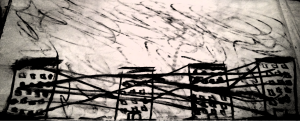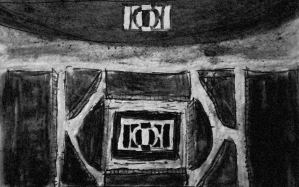“Cities, like dreams, are made of desires and fears, even if the thread of their discourse is secret, their rules are absurd, their perspectives deceitful, and everything conceals something else.”
In his brilliant novel Invisible Cities (PDF copy here!), Italo Calvino illustrated the seemingly ineffable aspects of urban developments by portraying a series of imaginary “cities.” Elevated to the realm of the fantastical, these cities are conceived as more than just physical structures but a confluence of ideas and emotions: the built crossroads of multitudinous lives.
Through a series of dialogues between a fictional Marco Polo and Kublai Khan, this enigmatic little book charts invisible terrain — the evolution of urban spaces throughout history, our modes of perception for experiencing them, and the conditions in which they flourish and wither. As the narrative progresses, it becomes clear that real-world places aren’t being described, but instead lenses through which cities can be seen: “the invisible order that sustains” them.
Now in the age of the Internet more than ever before, we interpret our world as the imagined Khan: navigating through reflections in “a desert of … interchangeable data, like grains of sand.” Our notion of the empirical realm is constantly being reformatted by the new information streaming into our perception through any number of devices.
The Architecture of the Fantastical
These “Invisible Cities” function as thought experiment for urban studies. A dialectic burgeons from the synthesis of conceptual and visual realms, and drives us toward a more holistic interpretation of landscape. This has been of particular interest to me as I’ve decided to pursue a degree in environmental design.
Architects usher along the transformation of space to place — the depolarization of raw geography into the human sphere of influence — so they must consider the physical ramifications of their work as much as the more opaque impacts. Seeing as architecture transcends physical forms, literature provides a fruitful platform through which we can examine landscape and our relationship with it. However, as Calvino cautions,
“At times he thought he was on the verge of discovering a coherent, harmonious system underlying the infinite deformities and discords, but no model could stand up”
The cities are thematically grouped by the aspect through which they can be expressed and interpreted. There are 11 classes of cities portrayed in the book. I drew representations of a few of them.
- Cities and Memory: Zirma and Zora force their existence into the travelers’ memories. Whether they exist, on Earth, though, is a matter for debate. To Polo, in his travels, “Elsewhere is a negative mirror.”
- Cities and Desire: These are cities shaped by the desires of their inhabitants, like Zobeide, modeled on dreams, or Despina, which reflects the desires of approaching travelers, presenting an oasis to desert-goers and land to seafarers. Such cities — and their residents — risk being choked by their very idealism.
- Cities and Signs: Signed cities are formed by the very indicators meant to represent them, and are thus imbued with hyperreality. The reference becomes the content; the content becomes unknowable, defined and restricted by the medium and the untenability of pure representation. Tamara, for instance, is so clogged by signs one cannot see its true state, the objects underneath.
- Thin Cities: This class of city rests upon thin foundations, swaying in a delicate balance. Existing in such a precarious position means their lives are defined by the essential resource that is the key to their survival. An example is Isaura, which is perched atop an underground lake such that “an invisible landscape conditions the visible one; everything that moves in the sunlight is driven by the lapping wave enclosed beneath the rock’s calcareous sky.” Consequently the city developed two forms of religion: those who worship the underground lake, and those whose gods are the water pumps and wells.
- Trading Cities: Defined by social relations and exchanges, in trading cities such as Ersilia, relationships within the city are represented by strings whose colors indicate the nature of the connection. When the network becomes too dense the city is abandoned and in its ruins “spider-webs of intricate relationships [seek] a form.”
- Cities and Eyes: In cities like Valrada, inhabitants are fixated on perception. The city was constructed so all its points reflect in its aqueous mirror, the lake below, both denying and increasing values. Everything is symmetrical, answered, inverted.
- Cities and Names: Defined more by references that exist on the map or in an atlas than their real-world geography. Irene seems to exist in name only, as a “city in the distance, and if you approach, it changes.”
- Cities and the Dead: Cities more defined by past inhabitants than those left living; or cities racked with anxieties about the ephemeral nature of life.
- Cities and the Sky: Celestial cities use the cosmic order as a structural model, mimicking its natural harmony in an attempt to attain perfection. Thekla and Perinthia use the stars as a blueprint for the city’s construction. Andria is built so its streets follow the planetary orbit, the buildings and spaces repeat the order of the constellations, the people “part of an unchanging heaven, cogs in a meticulous clockwork.”
The Continuous and Hidden cities appear to be cautionary tales, or predictions for the near future. One need not look further than our own swollen, sprawling metropolises to see Calvino’s apprehensions already realized.
- Continuous Cities hark to the waste produced by urban industrial societies. Leonia is refashioned every day with things bought just to replace the old, thrown out. The city is surrounded by mountains of trash, is threatened by landslides. “Perhaps the whole world, beyond Leonia’s boundaries, is covered by craters of rubbish each surrounding a metropolis in constant eruption.” Cities like Penthesilea are so vast and ambiguous that it’s not even clear when one is inside or outside of them, and Cecilia has absorbed all its surroundings with growth.
- In the Hidden Cities, nature has been conquered. In Theodora, for instance the result is a city “closed, aseptic… [where man] had finally reestablished the order of the world which he had himself upset.”
Khan: “Why do you speak to me of the stones? It is only the arch that matters to me.”
Polo: “Without stones there is no arch.”



